A prescription for overthinking
with a side effect of better health and happiness. Oh, and it's free.
Do you ever have a million different ideas running through your head at once, or is it just me? I often feel as though there is so much going on; so much I want to say, that’s it’s hard to filter it into one thing to turn into a newsletter that’s worth mine, and more importantly your1 time.
Whenever I read the news or one of the many thought-provoking articles on Substack, I come up with a new idea and often begin writing, only to then change my mind and start another. Overthinking appears to be one of my zone-of-genius talents.
So today, I want to tell you about a place where I have learned go when I need to quieten the noise, and cleanse my kokoro2. A place that you might enjoy, too?
This is my prescription for overthinking:
The sky.
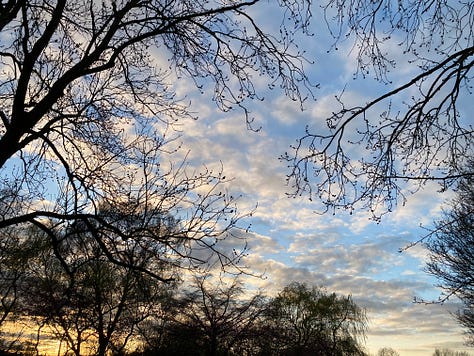
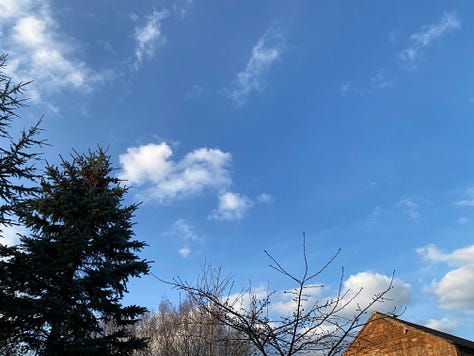


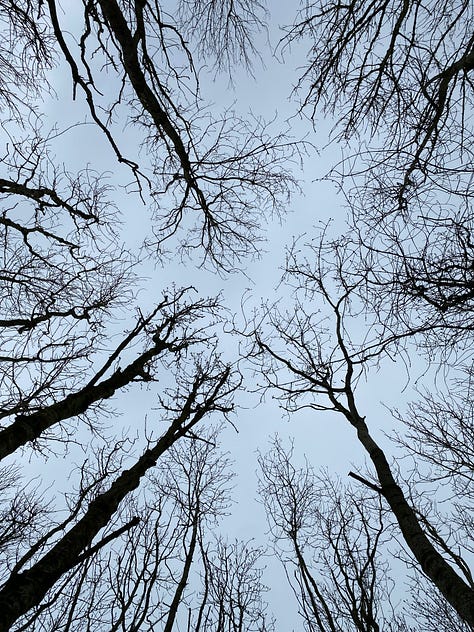
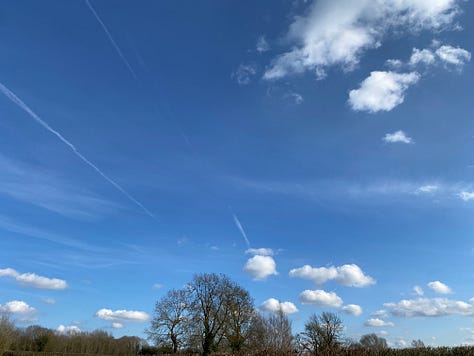
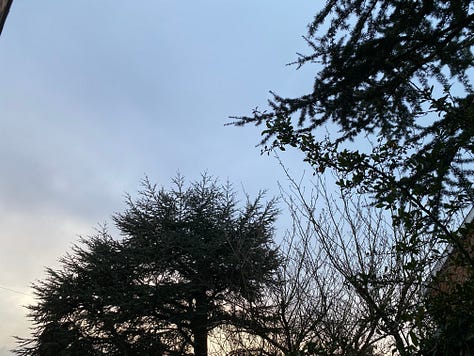


I’ve long held a fond fascination for the overhead scenery that greets our every day and night. It calms, it excites, it gives my mind freedom to wander and my thoughts a safe place to go. It’s always there. Wherever in the world I am, however unaccustomed I may be to the geography and climate, however unfamiliar the arrangement of stars or orientation of the moon, if I step outside, I can look up at the sky and marvel. It’s only very recently though, that I’ve done so consciously. Awake, and aware. And, I’m not quite sure why I found this so surprising, but I feel far better for it.
What even is the sky?
Linguistically, the sky is the area above the earth, where the clouds, the sun etc. can be seen3. Scientifically, it is the atmosphere which envelopes and protects our planet. It is the air we breathe4. It is a conceptual dome or celestial sphere5 upon which an infinite palette of colours, meteorological phenomena and the entities of the universe are observed. It is our source of day, and of night, of life, and of light, and the inspiration for countless literary works, even the greatest of which cannot compare to its magnitude nor magnificence.
But more than that, for me it represents at the same time, the grounding of knowing my place in the world, and my connection to every other human within it.
By night I watch for satellites, appearing at first glance like a shooting star as they trace their orbital path across the dark. By day, in its indescribable, ever dancing beauty I am reminded that however small and inconsequential I may feel, my potential is defined only by my imagination. As my high school teacher wrote in my leavers’ book, and I reflect for every one of us reading this: the sky really is the limit.
The sky is like a page from a book that hasn’t been written —François Camoin
The sky and medicine
Considering sky-gazing from a medical perspective (I know, I can’t help myself, you can take the woman out of medicine…), the health benefits of exposure to natural light are well documented. Human biology depends on the cycles of planetary day and night to regulate our circadian rhythms. Sleep and wakefulness, mental wellness, cognition, bone health and immunity are all intricately related and reliant on adequate exposure to daylight and darkness.
Unfortunately for many of us, we simply do not see the sky enough.
In my previous life as a surgeon, it was disturbingly common to spend the majority of a day, every working day, even, without seeing daylight.
Operating theatres - at least, every one I’ve ever attended - have no windows. Many of the corridors and offices that I spent my hours and years in had no view of the sky. Long days meant that it wasn’t unusual to leave my apartment early in the morning via the underground parking garage, to drive across a still-dark city to a multistorey car park that linked directly in to the hospital atrium, never setting foot outside. I might catch a glimpse of the outdoors through a tinted ward window, but too busy to stop and look out at the world, I would complete the journey in reverse after sunset when the evening had grown dark.
I have learned that at times when I go too long without seeing the sky, there is a melancholy and even anxiety that is hard to escape, and in this experience, I am not alone. In fact, research suggests that around a third of UK adults suffer from an appreciably lower mood in autumn and winter, with 3% having symptoms significant enough to receive a formal diagnosis of Seasonal Affective Disorder6; this Winter Depression being evidence that the very molecules within our brains need sunlight to optimally function.
If this was my experience as a staff member within a hospital, what is the impact on our patients, then? In particular, what of those enduring lengthy admissions who may be confined to the indoors for weeks, months or even years?
The very nature of an injury, illness or effect of treatment that has been significant enough to require admission to a ward, invariably renders patients especially vulnerable to the adverse consequences of a lack of natural light. Modern hospital designs attempt to mitigate this impact by intentionally locating patient facilities on the windowed aspects of a ward space, with staff areas then often sited centrally or adjacent to corridors. Still, patients nursed in bays often ask to be moved to a bed right next to a window when available, craving a better view of the outside world, and with good reason. Light in isolation is not quite enough: the view matters, too.
It has been well documented in research for more than 40 years7 that health outcomes of inpatients are improved by a natural view. Patients recover faster and even report reduced pain, if they can see the greens and blues of nature’s wealth than if their window looks out onto a grey or brick-red wall.
Our bodies and our minds can only survive and thrive if we can see the sky.
I have been fortunate that even at my busiest, life was never all work and no sky. From that same Liverpool apartment I enjoyed a spectacular view across the city, the river and across as far as the mountains of Wales on a clear day. At night I could enjoy the city lights and sounds, including a wonderful moment when I heard what sounded like the city itself singing its heart-song You’ll Never Walk Alone, during the interval performance of the Eurovision finals in the summer of 2023. Watching from my window as the arena lights beamed coloured arcs onto the canvas of a clear night was a spectacle of joy. But as I’ve learned on many a winter afternoon walk home from school with my children (now that I get to enjoy that ritual much more often), the sky itself is pretty talented at putting on a show without any human interference at all. When clouds dance and blues fade into streaks of fuschia and fire, I feel alive, and often pause simply to bear witness.
How much sky-gazing do we need?
As easy as it is to say that we need natural light and a nice view, what exactly should we be aiming for?
Researchers studying the relationship between exposure to daylight and likelihood of depressive symptoms in the far northern latitudes of Scandinavia, where climate change is further reducing the already extremely limited winter daylight, suggest that an hour of time spent in daylight may be enough to be protective8.
We are fortunate in the UK. Even at the winter solstice, our shortest day, in my Midlands village we can expect seven hours and 36 minutes of daylight.9 At more extreme latitudes, winter daylight becomes severely limited. In the arctic and antarctic circles, polar night means that the sun sets in autumn and is not seen again until spring. In Tromsø in northern Norway, for seven weeks in winter the sun will not rise above the horizon at all.
Interestingly though, as one study10 comparing seasonal sadness among students in Norway with those in Italy found, seasonal variation in mood appears not to be associated with latitude, rather with climate conditions that impact one’s comfort when spending time outdoors.
There is evidence that genetics11 play a part, but mindset matters. The Norwegian concept of koselig, like the perhaps more widely known Swedish hygge, focuses on creating a cosy atmosphere within the home and community. And the Norwegian saying “Det finnes ikke dårlig vær, bare dårlige klær”, translated as “there is no bad weather, only bad clothes” encourages a positive attitude towards winter and outdoor activity all year round.
Even at times of polar night, it is not entirely dark in Tromsø. Civil twilight is the time when the sun is less than six degrees below the horizon and provides a few hours of illumination bright enough that artificial lighting may not be required. And, long winter nights provide an excellent opportunity to observe one of the most spectacular displays that the sky has in its gift: the Aurora Borealis, or Northern Lights.
I recently saw the Aurora for the very first time, when a geomagnetic storm brought them further south than their usual reaches. Even with the intensity obscured by light from streetlamps and nearby cities, the vivid, shimmering green and red sky took my breath away.
But, so did the intense cobalt blue of a winter morning sky, not yet warm enough to melt the frosted branch of a skeleton tree where I watched a blackbird perch. So did the incredible planetary alignment of last month, when my children would point out five planets during a five minute walk from school. And so does the minute-by-minute artwork of a summer sunset, observed from the gatepost of a local farmer’s field.
Looking at the sky; really seeing it, has taught me the joy of living in the present moment. To be awake to the wonders of this one precious life, on this planet, in this universe. This small daily practice of pause; of taking a moment to notice the colours and the clouds, or the stars and the moon, has changed me. Friends and family have commented on my transformation. I am happier. I have found a peace that previously felt elusive. It turns out that the only medicine I needed, was the sky. I wonder what it might do for you, too? Perhaps you might like to try it, and let me know?
Louise x
If you are interested, a recent poem I wrote that was inspired by the sky can be found here:
Poem on a Post-It [11]
In this week’s Beth Kempton Ink and Flame class, I focussed on poetry. I’m sharing this one today as it ties in beautifully with the topic of my latest essay, called A prescription for overthinking.
In other big news this week, my new page LiveStack is now open.
The community on Substack has changed my life. Seriously. Now I want to meet you…
Are you interested in attending real life events for creatives & Substackers?
Me too!
Come join me - LiveStack free-to-read Directory coming soon & LiveStack UK Conference is happening…. sign up to be the first to receive updates and tales from behind the scenes of my crazy big dream.
Do you host in person/hybrid events such as
workshops?
retreats?
co-working?
anything else?
Listings are free forever for the first 100 LiveStack (free!) subscribers. Sign up today, can’t wait to hear about your events!
Please share widely, this only works if the community has an appetite for it.
Lots of love!
Extra important, because there are now 257 wonderful humans reading Anatomy of a Decision, which is frankly incredible, thank you!
Kokoro, as defined by
in her book Kokoro is:a profound Japanese term which represents the intelligent heart, the feeling mind and the embodied spirit of every human being
NASA: The Sky Above Us
Daylight length on the UK mainland on the winter solstice ranges from 6h17m at John O’Groats, Scotland’s most northerly point to 8h5m at Lizard Point in Cornwall, England’s southern tip. Enter your location on this fascinating chart to find out exactly what to expect where you are, along with precise sunrise, twilight and sunset times for every day of the year. Sunrise and sunset times in Lizard Point









![Poem on a Post-It [11]](https://substackcdn.com/image/fetch/$s_!V2lu!,w_280,h_280,c_fill,f_auto,q_auto:good,fl_progressive:steep,g_auto/https%3A%2F%2Fsubstack-post-media.s3.amazonaws.com%2Fpublic%2Fimages%2Fc1d4b17e-e81f-456c-a3a1-a7516c266420_1080x1080.png)

I love how you bring attention to the vastness of the sky always being there for us, a grounding of knowing our place in the world and the joy of being present and curious about it as it changes every day and night. When you write... When clouds dance and blues fade into streaks of fascia and fire....I can imagine the most gorgeous sunset, thank you. I've met you on Beth's BPM course - see you soon
I loved this piece - the sky is kind of magical. The first thing I do in the morning is stand in the garden, look up at the sky, and breathe it in. I love this little ritual, it grounds me 💫